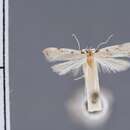Comprehensive Description
provided by Smithsonian Contributions to Zoology
Aniuta ochroleuca
Alar expanse 12–13 mm.
Labial palpus pale ocherous white; second segment, except apex, fuscous on outer side; third segment fuscous apically. Antenna buffy brown; scape fuscous dorsally. Head white; scales around base of scape fuscous. Thorax ocherous white; tegula white except base fuscous. Forewing ground color ocherous white to white; base of costa fuscous; at apical third of costa a fuscous spot; in middle of cell an oblique fuscous dash and a spot of same color at end of cell; at middle, dorsally, a fuscous suffusion and a shade of similar color around termen; cilia ocherous white with a suffused grayish subbasal line. Hind wing white, pale buff distally; cilia pale buff. Foreleg ocherous white with fuscous suffusion on outer side; midleg similar; hind leg ocherous white with a suggestion of a few obscure grayish spots. Abdomen ocherous white, slightly darker posteriorly; not setose.
Male genitalia slides USMN 24121, 24238. Harpe ample, dorsal and ventral edges nearly parallel; cucullus rounded; sacculus produced distally as a sharp spine. Uncus broad basally, narrowed distally. Vinculum with saccus produced, V-shaped. Tegumen short, broad. Anellus a small rectangular plate with a broad median anterior arm; posterior corners of central plate articulated with elements of transtilla. Aedeagus rather slender except broadened proximally; cornuti absent.
Female genitalia slide USMN 24239. Ostium pear shaped. Antrum a sclerotized band. Inception of ductus seminalis near posterior end of ductus bursae. Ductus bursae very slender and sclerotized most of its length. Bursa copulatrix membranous. Signum a large, transverse, triangular, sclerotized plate with serrate anterior edge.
HOLOTYPE.—USNM 73691.
TYPE-LOCALITY.—Llanquihue, Peulla.
Described from the male holotype (9 Mar 1959, J. F. G. Clarke), 2 male and 2 female paratypes as follows: male, Peulla (7 Mar 1959); male, 2 females, Petrohue (10–12 Mar 1959), all from Llanquihue Province, collected by J. F. G. Clarke.
- bibliographic citation
- Clarke, J. F. Gates. 1978. "Neotropical Microlepidoptera, XXI : new genera and species of Oecophoridae from Chile." Smithsonian Contributions to Zoology. 1-80. https://doi.org/10.5479/si.00810282.273
Aniuta ochroleuca: Brief Summary
provided by wikipedia EN
Aniuta ochroleuca is a moth in the family Oecophoridae. It was described by John Frederick Gates Clarke in 1978. It is found in Chile.
The wingspan is 12–13 mm. The forewings are ocherous white to white with the base of the costa fuscous. At the apical third of the costa is a fuscous spot and in the middle of the cell is an oblique fuscous dash and a spot of the same color at the end of the cell. At the middle, dorsally, is a fuscous suffusion and a shade of similar color around the termen. The hindwings are white, pale buff distally.
- license
- cc-by-sa-3.0
- copyright
- Wikipedia authors and editors

